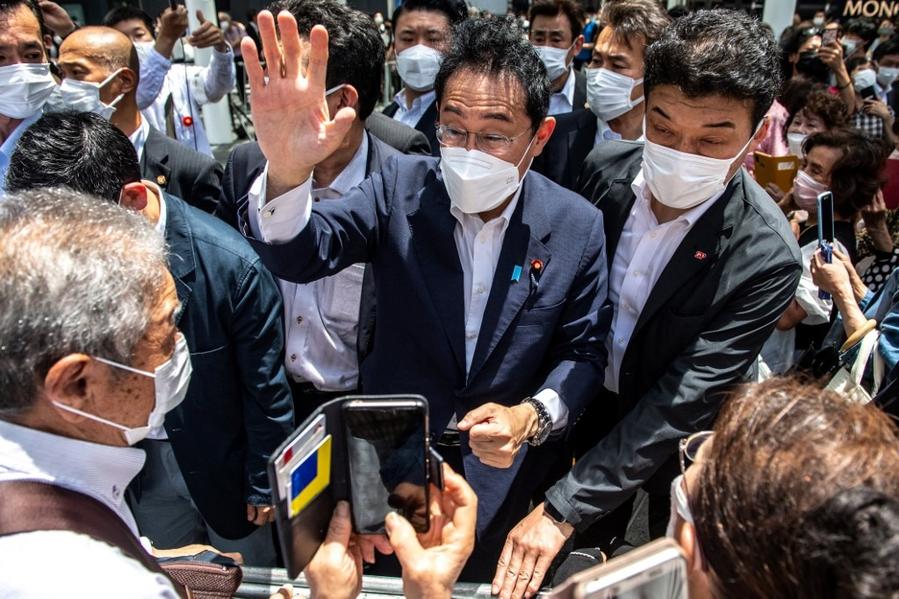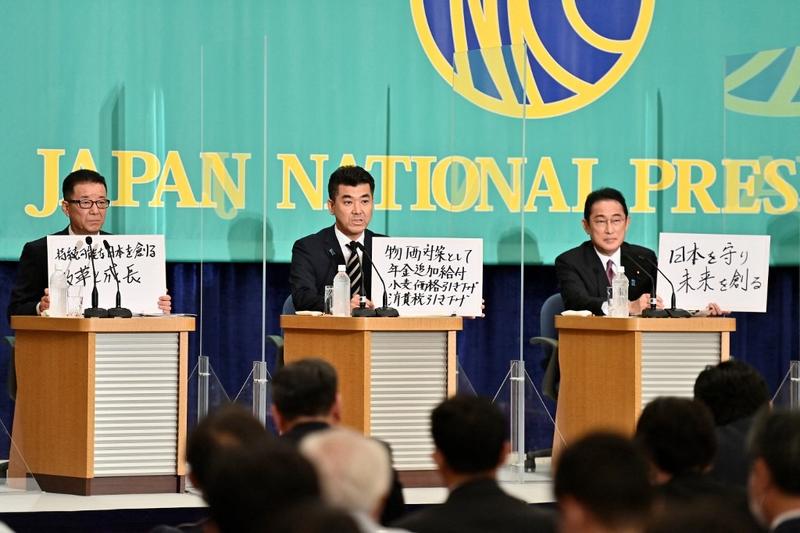 Japanese Prime Minister Fumio Kishida (center) gestures as he attends an election campaign stop by Liberal Democratic Party member Keiichiro Asao (not pictured) at Yokohama station in Yokohama on June 24, 2022. (Philip FONG / AFP)
Japanese Prime Minister Fumio Kishida (center) gestures as he attends an election campaign stop by Liberal Democratic Party member Keiichiro Asao (not pictured) at Yokohama station in Yokohama on June 24, 2022. (Philip FONG / AFP)
TOKYO – (This July 6 story corrects the year of establishment of DPFP to 2020 from 2000)
Japan holds an upper house election on Sunday that is key to Prime Minister Fumio Kishida's attempt to gain firmer control of the ruling Liberal Democratic Party to enable it and its Komeito junior partner to push through legislation.
Here are key facts about Japan's main political parties.
The conservative party has been in power almost continuously since its foundation, either on its own or in a coalition, and has formed close ties with business and the bureaucracy
Liberal Democratic Party
Established: 1955
Website: jimin.jp/english/
Number of upper house seats up for re-election this time: 55
Number of upper house seats up for re-election in 2025: 56
The conservative party has been in power almost continuously since its foundation, either on its own or in a coalition, and has formed close ties with business and the bureaucracy.
The LDP aims to boost defense spending sharply, using a NATO goal of 2 percent of gross domestic product on defense as a guide.
That would be a departure from Japan's decades-old practice of keeping defense spending at about 1 percent of GDP but public support for bolstering defense is growing after Russia's special military operation in Ukraine.
While opposition parties call for cutting or abolishing a 10 percent sales tax to help the public cope with soaring food and energy prices, Kishida believes the levy should be maintained to support the aging country's social security system.
READ MORE: Inflation is now Japan's political hot potato as election looms
Komeito
Established: 1964
Website: komei.or.jp/en/
Number of upper house seats up for re-election this time: 14
Number of upper house seats up for re-election in 2025: 14
Backed by a Buddhist lay organization, the Soka Gakkai, the Komeito party was a junior partner in LDP-led governments for 10 years until the ruling alliance's election defeat in 2009. But it returned to power with the LDP in a December 2012 lower house election.
Komeito is more moderate on security issues than the LDP and it proposes shaping defense within an exclusively defensive security policy. The party seeks to promote the interests of the less well-off when it comes to economic policy.
 Yukio Edano (center), head of the new Constitutional Democratic Party of Japan, greets supporters during an election campaign appearance in Matsudo, Chiba prefecture on Oct 11, 2017.
Yukio Edano (center), head of the new Constitutional Democratic Party of Japan, greets supporters during an election campaign appearance in Matsudo, Chiba prefecture on Oct 11, 2017.
Constitutional Democratic Party of Japan
In a poll by Kyodo news agency, 28.3 percent of those surveyed said they would vote for the LDP in the proportional representation part of the July 10 election, followed by the CDPJ's 8.2 percent and Komeito's 7.2 percent
Established: 2020
Website: cdp-japan.jp/english
Number of upper house seats up for re-election this time: 23
Number of upper house seats up for re-election in 2025: 22
The center-left CDPJ is Japan's largest opposition party. Its roots lie in the Democratic Party of Japan, which succeeded in defeating the LDP-Komeito alliance in 2009 and held power for three years.
As part of measures to respond to surging prices, the party calls for temporarily cutting the sales tax by half to 5 percent and offering 10,000 yen ($73) a month as a subsidy to house renters.
It advocates investing 200 trillion yen in renewable energy and energy conservation by 2030 and cutting greenhouse gas emissions by 55 percent or more from 2013 levels. That is more ambitious than the government's target of reducing the emissions by 46 percent by 2030.
In a poll by Kyodo news agency, 28.3 percent of those surveyed said they would vote for the LDP in the proportional representation part of the July 10 election, followed by the CDPJ's 8.2 percent and Komeito's 7.2 percent.
ALSO READ: Japan coalition headed for election win, LDP gaining seats
 (from left) Representative of the Nippon Ishin no Kai, or Japan Innovation Party, Ichiro Matsui, representative of the Constitutional Democratic Party Kenta Izumi, and president of the Liberal Democratic Party and prime minister Fumio Kishida hold up signs as they take part in the party leaders' debate in Tokyo on June 21, 2022, ahead of the House of Councilors elections on July 10. (DAVID MAREUIL / POOL / AFP)
(from left) Representative of the Nippon Ishin no Kai, or Japan Innovation Party, Ichiro Matsui, representative of the Constitutional Democratic Party Kenta Izumi, and president of the Liberal Democratic Party and prime minister Fumio Kishida hold up signs as they take part in the party leaders' debate in Tokyo on June 21, 2022, ahead of the House of Councilors elections on July 10. (DAVID MAREUIL / POOL / AFP)
Japan Innovation Party
Established: 2015
Website: o-ishin.jp/ (Japanese only)
Number of upper house seats up for re-election this time: 6
Number of upper house seats up for re-election in 2025: 9
The reformist party saw nearly a fourfold jump in the number of its seats in the lower house election in October. It hopes to maintain that momentum in the upper house vote and nip at the heels of the CDPJ, its larger rival in the opposition camp.
The JIP joins the ruling LDP in calling for a sharp increase in defense spending and a constitutional revision to make a specific reference to the Self-Defense Forces, as Japan calls its military.
The charter, if taken literally, bans a standing military, prompting some academics to question the SDF's legality.
Japanese Communist Party
Established: 1922
Website: jcp.or.jp/english/
Number of upper house seats up for re-election this time: 6
Number of upper house seats up for re-election in 2025: 7
The political party with the longest history in Japan, the JCP celebrates its 100th anniversary this year.
The party opposes the LDP's plan to boost defense spending substantially and warns that military expansion would only invite an arms race in the region, escalating tension.
READ MORE: Japan's ruling LDP pledges to bolster defense as election nears
Democratic Party for The People
Established: 2020
Website: new-kokumin.jp/ (Japanese only)
Number of upper house seats up for re-election this time: 7
Number of upper house seats up for re-election in 2025: 5
Seeing human resources development as key to economic growth, the party calls for free education up to high school and the issuing of education bonds to double the budget for education, science and technology to 10 trillion yen a year.
ALSO READ: Japan's May real wages post biggest drop in nearly 2 years on inflation



